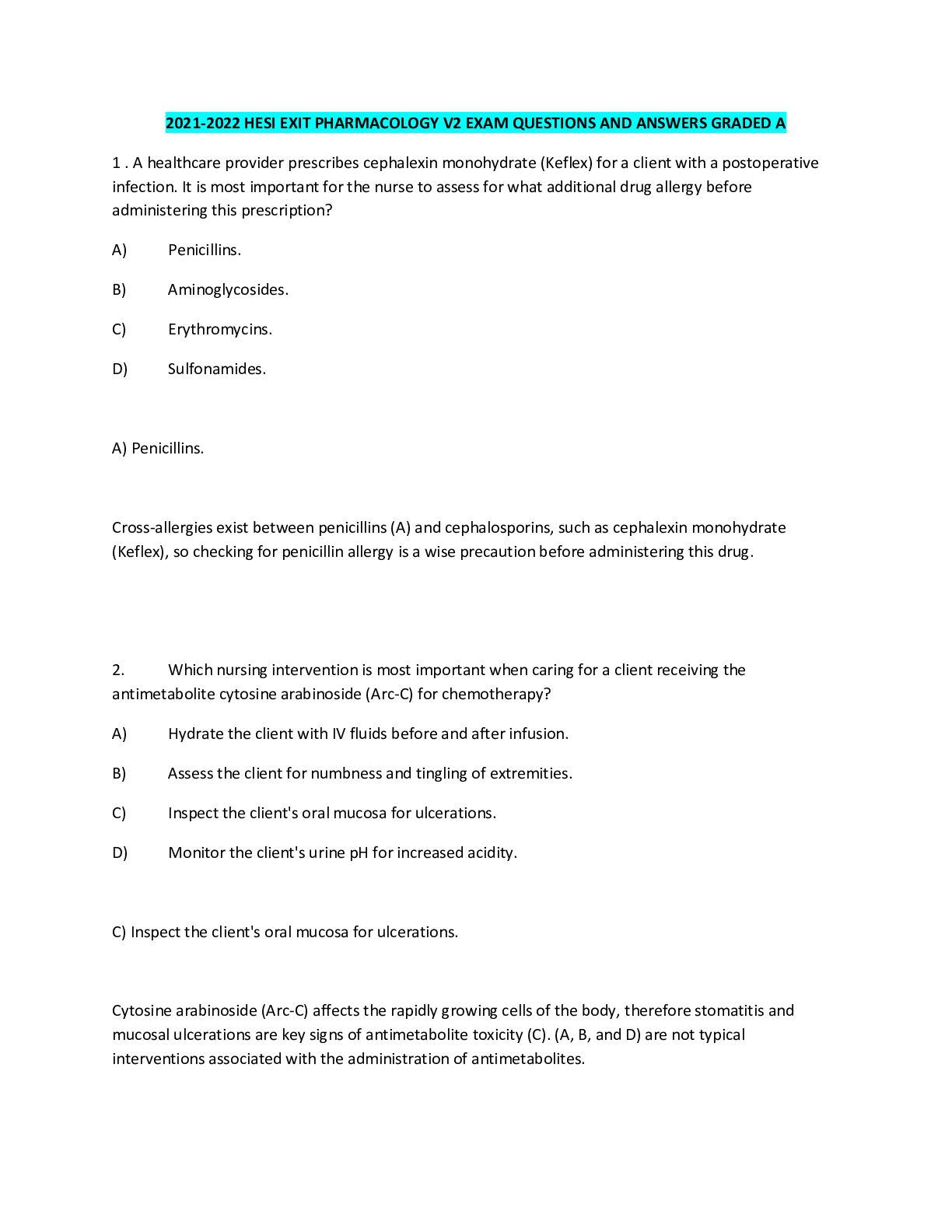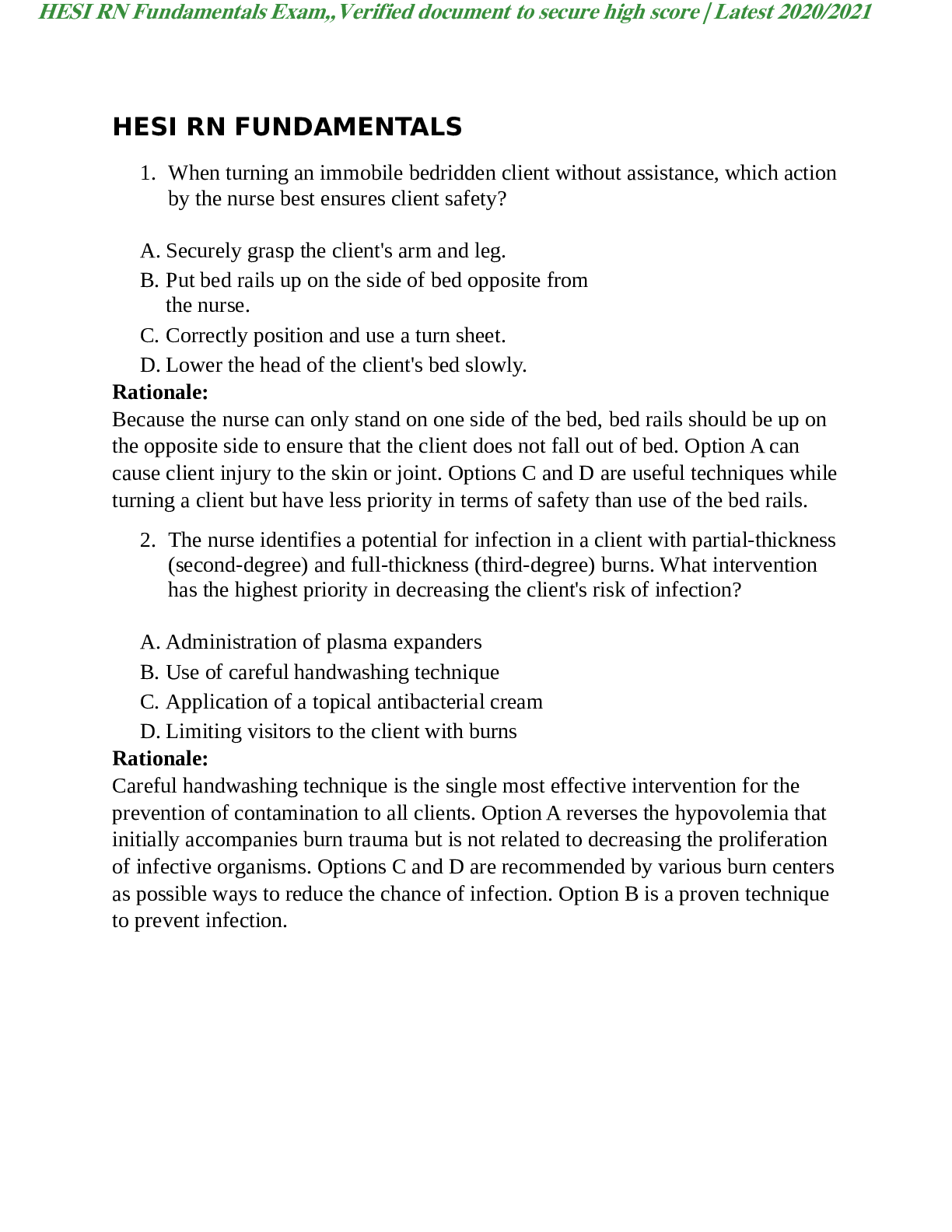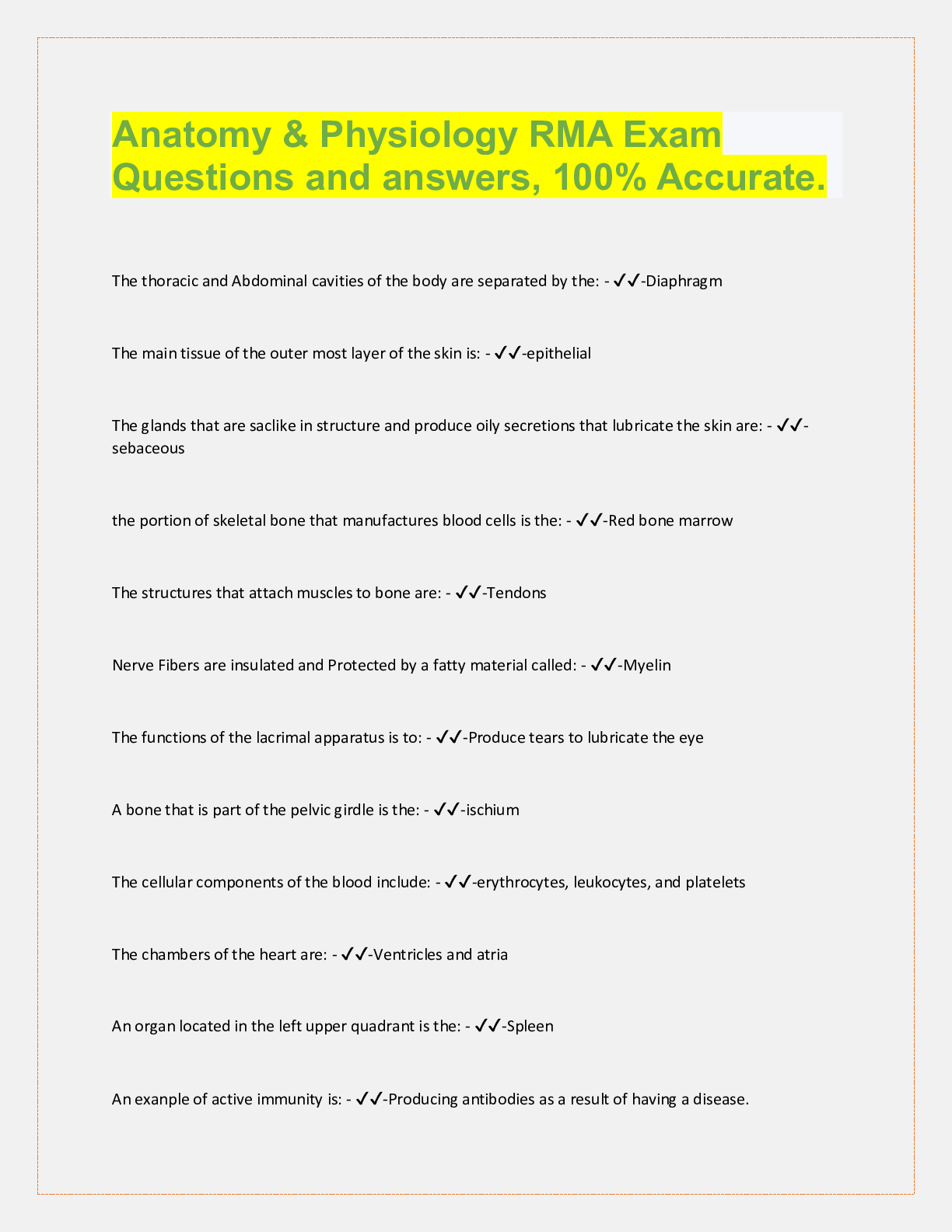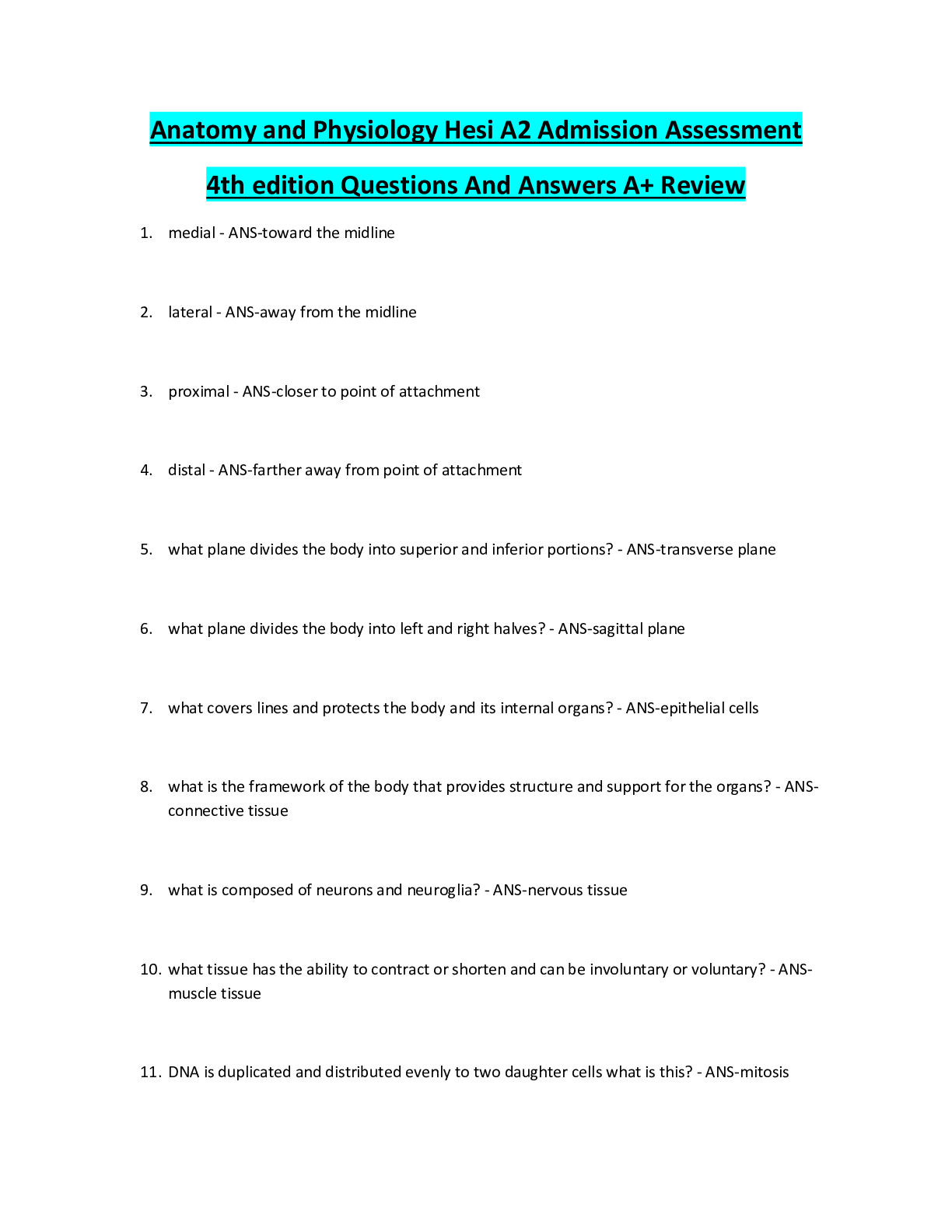Anatomy > HESI > Anatomy and Physiology HESI A2 Study Guide. Very Useful Guide for Passing in your Final Exams (All)
Anatomy and Physiology HESI A2 Study Guide. Very Useful Guide for Passing in your Final Exams
Document Content and Description Below
Table of Contents: Lesson 1 Skeletal System..................................................................................1 Lesson 2 Body Directions/Plans............................................ ...............................14 Lesson 3 Muscular System................................................................................21 *Lesson 4 Circulatory System.........................................................................26 *Lesson 5 Endocrine/Hormone System.........................................................33 Lesson 6 Urinary System...................................................................................37 Lesson 7 Integumentary System........................................................................42 Lesson 8 Digestive System................................................................................47 *Lesson 9 Nervous System..............................................................................50 *Lesson 10 Senses System...............................................................................54 *Lesson 11 Immune System............................................................................57 Lesson 12 Reproductive System........................................................................60 Comprehensive Practice Test.............................................................................61 Answer Key.......................................................................................................65 1. What is a clear, watery fluid found in the anterior and posterior chambers of the eye? a. Vitreous humor b. Ciliary body c. Lacrimal gland d. Aqueous humor 2. What is/are correct about the aqueous humor? A. It balances absorption and pressure in the anterior chamber B. It is secreted by the epithelium of the ciliary bodies C. Inability to circulate freely can cause elevated intraocular pressure that may led to vision loss. D. All of the above 3. Their primary role is to combat effects of histamine in allergic reactions, phagocytize antigenantibody complexes, and destroy certain parasitic worms. A. Neutrophil B. Lymphocytes C. Eosinophil D. Basophil 4. When a person is seen walking in heels, the ankle is described as being in what position? A. Plantar flexion B. Dorsiflexion C. Eversion D. Abduction 5. Which of the following statements best illustrates a correct anatomical position A. Standing erect without moving B. Standing up with palms held unnaturally forward with thumbs pointing away from the body C. Standing up with palms held unnaturally forward with thumbs pointing towards the body D. Both standing and lying down without moving 6. A frontal section divides the body into: A. Right and left parts B. Anterior and posterior parts C. Midsagittal and median section D. Superior and inferior parts Bone structure and functions © 2017 All Rights Reserved. www.ReadyForTheHESI.org 7. Which of the following is seen mostly inside the epiphyses of each long bone? A. Yellow marrow B. Cartilage C. Spongy bone D. Compact bone 8. Which of these statements describe the trochanter? A. Small rounded projection or process B. Raised area on or above a condyle C. Large rounded projection and may be roughened D. Very large, blunt, irregularly shaped process 1. Which of the following statements are true about bone markings? A. Bone markings are projections, depressions and openings found in the surface of the bones. B. They serve as sites of muscle, ligament and tendon attachment C. The openings serve as passages of blood vessels and nerves D. All of the above 10. In order to achieve normal bone growth and development, the following factors are essential. Which is not included in the list? A. High fat diet B. Growth hormone C. Sex hormones D. Vitamins A, C, and D 11. A person who suffered a traumatic injury in the inguinal area is most likely to die due to hemorrhage because of a severed A. Femoral artery B. Popliteal artery C. Carotid artery D. Brachial artery 12. Which of the following is correct about the epicardium? A. It is the pacemaker of the heart B. It lines the heart chambers C. It is the visceral epicardium D. It is also known as the parietal pericardium 13. The clinical instructor instructed the nursing student to palpate the carotid artery. Which of the following statements describe that the nursing student has located the carotid artery correctly? A. Halfway between the shoulder and elbow, in the middle of the inner arm, between the bicep and triceps muscles. B. Upper neck between the sternomastoid and trachea roughly at the level of cricoid cartilage. © 2017 All Rights Reserved. www.ReadyForTheHESI.org C. The inner thigh, at the mid-inguinal point, halfway between the pubic symphysis and anterior superior iliac spine D. In front of the tragus of the ear and up along the temple. 14. What artery supplies blood to the structures of the neck and face? A. Axillary artery B. Brachial artery C. Internal carotid artery D. External carotid artery 15. Which of the following is correct about the cerumen? A. It provides protection to the ear from bacteria, fungus, insects and water. B. Impacted cerumen can lead to dizziness and motion sickness. C. It is produced by the vibrations in the ear drum. D. It is found in the ear drum. 16. Chemoreceptor stimulation is associated with regulation of: A. Breathing B. Pain control C. Temperature D. Blood pressure 17. The three chambers, or scalae, that make up the interior of the cochlea are: A. Upper Vestibular Canal, Lower Tympanic Canal, and Cochlear Duct B. Perilymph, Endolymph and Cochlear Duct C. Upper Vestibular Canal, Lower Tympanic Canal, and Organ of Corti D. Lower Tympanic Canal, Cochlear Duct and Organ of Corti 18. The other name for ear drum is: A. Cochlea B. Organ of Corti C. Tympanic membrane D. Outer ear 19. Fertilization usually occurs in the: A. Uterus B. Outer third portion of the fallopian tube C. Ovaries D. Lower portion of the fallopian tube. 20. The life span of a normal RBC is approximately. © 2017 All Rights Reserved. www.ReadyForTheHESI.org A. 120 days B. 13 to 20 days C. 8 to 9 days D. 30 days 21. Hemoglobin consists of ______ globin molecules and _____ heme groups. A. 4,2 B. 1,2 C. 4,1 D. 2,4 22. The ovaries produce and release the following hormones: A. Luteinizing hormone and Follicle-Stimulating Hormone B. Estrogen and progesterone C. Melatonin D. T4, T3, and calcitonin 23. The hormone that is secreted by posterior pituitary gland: A. Prolactin B. Oxytocin C. Growth-stimulating hormone D. Thyroid-stimulating hormone 24. The mitral valve lies between the: A. Right atrium and the right ventricle B. Left atrium and left ventricle C. Just below the tricuspid valve D. Opposite to the pulmonic valve 25. The following are functions of skeletal muscles in the body, except: A. Structure B. Movement C. Heat D. Posture 26. Which muscle type is considered voluntary? A. Smooth B. Cardiac C. Eimysium D. Skeletal 27. Which of the following is not true about the occipital lobe? A. It is responsible for processing visual information © 2017 All Rights Reserved. www.ReadyForTheHESI.org B. It is responsible for hearing and memory C. Lesions to this area can cause visual hallucinations D. It is located in the rearmost portion of the skull 28. The olfactory nerve is typically considered the cranial nerve A. I B. II C. III D. IV 29. A pea-sized structure located at the base of the brain, just below the hypothalamus A. Adrenal gland B. Pineal gland C. Pituitary gland D. Thyroid gland 30. At which level does the spinal cord ends? A. L4 B. L3 C. L1 or L2 D. L4 or L5 31. Which is the most important risk factor for ankle sprains? A. A history of previous ankle sprain B. Gender C. Rear foot valgus D. Short Achilles tendon 32. The mechanism of injury in ankle sprains. A. Plantar flexion B. Inversion C. Dorsiflexion and eversion D. Plantar flexion and inversion 33. During a rigorous activity such as exercise, the body temperature increases. Which of the following actions or events take place in the body to return the body back to homeostasis? A. Blood flow decreases B. Sweating increases C. Shivering increases D. Temperature increases more © 2017 All Rights Reserved. www.ReadyForTheHESI.org 34. The part of the brain that is involved in primary auditory perception and holds the primary auditory cortex. A. Frontal lobe B. Occipital lobe C. Temporal lobe D. Parietal lobe. 35. The large vessel that carries deoxygenated blood from the lower and middle body into the right atrium of the heart. A. Superior vena cava B. Pulmonary arteries C. Pulmonary veins D. Inferior vena cava 36. The vessel that carry oxygenated blood back to the heart and left atrium are: A. Superior vena cava B. Pulmonary arteries C. Pulmonary veins D. Capillaries 37. The abdominal region located at the right side of the umbilical area is called: A. Right iliac region B. Right lumbar region C. Right hypochondriac region D. Epigastric area 38. To maintain homeostasis, the body function interacts. The homeostatic control mechanism that responds to environmental changes is called: A. Stimuli B. Control center C. Receptor D. Effector 39. The cranial nerve that is responsible for carrying images from the eyes to the brain. A. CN I B. CN II C. CN III D. CN IV 40. The dorsal cavity of the body has two divisions. Select all dorsal body cavity: A. Thoracic B. Cranial C. Spinal D. Abdominal A. A and B B. B and C C. C and D D. B and D © 2017 All Rights Reserved. www.ReadyForTheHESI.org 41. Which of the following leukocytes are most important for phagocytizing microorganisms and foreign substances? A. Neutrophils B. Macrophages C. Basophils D. Eosinophils A. A and B B. A and C C. A and D D. B and C 42. The gain or loss of heat as infrared energy between two objects that are not in physical contact with each other is called A. Evaporation B. Radiation C. Conduction D. Convection 43. After fertilization, development of a full-term fetus depends upon A. release of HCG by the trophoblast to maintain the corpus luteum. B. production of LH by the placenta. C. maintenance of the corpus albicans by prolactin. D. production of estrogen by the adenohypophysis. 44. The anatomical region of the armpit is called: A. Antecubital B. Acromial C. Abdominal D. Axillary 45. The anatomical region where the carotid arteries and jugular veins are located: A. Nuchal B. Cervical C. Acromial D. Coxal 46. The nursing student is correct to say that the frenulum is part of the: A. Teeth B. Esophagus C. Muscles of mastication D. Tongue 47. Which of these descriptions of the heart's location is correct? A. The heart lies obliquely in the mediastinum. B. Its base is directed anteriorly and slightly superiorly. C. Two-thirds of the heart's mass lies to the right of the midline of the sternum. © 2017 All Rights Reserved. www.ReadyForTheHESI.org D. All of these 48. What happens if the sinoatrial node fails? A. The heart will stop. B. The ventricles will contract, but the atria will stop. C. Another part of the heart, possibly the AV node, will become the pacemaker. D. The heart will beat faster. 49. What is the process by which molecules are moving from an area of higher concentration to an area of lower concentration to become evenly distributed? A. Active transport process B. Diffusion C. Passive transport process D. Filtration 50. An adolescent has been participating in a competitive sport game. Accidentally, he fell off and complains of pain in his coxal area. The adolescent has pain on: A. Hip area B. Thigh area C. Point of shoulder D. Posterior knee area [Show More]
Last updated: 2 years ago
Preview 1 out of 95 pages

Buy this document to get the full access instantly
Instant Download Access after purchase
Buy NowInstant download
We Accept:

Reviews( 0 )
$15.00
Can't find what you want? Try our AI powered Search
Document information
Connected school, study & course
About the document
Uploaded On
Apr 08, 2021
Number of pages
95
Written in
Additional information
This document has been written for:
Uploaded
Apr 08, 2021
Downloads
0
Views
121














.png)




